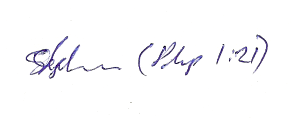
Problems with Greek text
#1

Posted 20 March 2012 - 12:24 PM
Thank you in advance.
#2

Posted 20 March 2012 - 12:43 PM
I am new to this site and I have a question that I hope can be readily answered. I am very much impressed with the ability to create modules for e-Sword with the ToolTip Tool. I have been able to create several modules for several English translations that do not seem to be available for e-Sword. I would like to be able to do the same with several Greek texts, but up to this point my efforts to do so have been a colossal failure. I am able to get the necessary Greek text in RTF format and place it in the ToolTip Tool and it displays perfectly. When I make the e-Sword module and load the new module in e-Sword what appears is not my previously well formatted Greek text but something unreadable. In other words, it seems that the ToolTip Tool can read and display the Greek text just fine, but e-Sword cannot. There are other Greek texts that can be opened and used by e-Sword, so I am stumped as to why my user-created modules will not. Can anyone offer any help?
Thank you in advance.
Unfortunately, it takes some technical skill to create resources with Greek text, even with Tooltip. This problem makes Greek resource creation (for commentaries and dictionaries) in e-Sword beyond the reach of 99% of users.
Let me give you a quick overview:
After you generate your module, if you open the module in a database editor (or export the text to a text file and view in a word processor), you will see RTF tags like \f0 english here and then \f1 greek text here. So, \f0 is the e-Sword user's default font. \f1 is the e-Sword user's default Greek font. When e-Sword sees the hidden tag \f0, e-Sword uses the default display font, which is Georgia by default. if e-Sword sees \f1, e-Sword renders the text in the user's Greek font, Titus Cyberbit Basic, by default.
Tooltip makes a character set determination of what ToolTip believes to be Greek. It isn't always "right", though, when the Greek diacritics are involved. When you see garbled Greek in e-Sword, Tooltip tagged that text \f0. That text should be tagged \f1.
I get around this by coloring my Greek words blue (on the RGB scale, that's R=0, G=0, B=255). Then I create my e-Sword module and export the text to a word processor for editing. Finally, I search the raw RTF text for \cf2 (or whatever the color for blue is). Usually it will read \cf2\f0 greek text here. I search replace \cf2\f0 to \cf2\f1 to FORCE that font into be Greek. \cf is the color designation in RTF. I think blue is \cf2 in e-Sword--I can't remember off hand but it's easy to determine by finding text you know is blue and looking at the color designation (\cf#).
Sorry it's that complex. It's not "hard". It's just a hassle once you know how to do it. I'll be happy to make that change for you, if your text is colored blue. The blue color is necessary so we can search/replace the text--otherwise we won't be able to distinguish between Greek text and English text. We can't change \f0 to \f1 if we don't know which text should be f1. This method obviously assumes that no other text in your document is blue.
#3

Posted 20 March 2012 - 12:46 PM
#4

Posted 20 March 2012 - 01:34 PM
Please forgive me for being somewhat dense, but I find myself a bit confused. Therefore, if you do not mind, I will set a few questions before you.
After you color the Greek words blue and create your e-Sword module, exactly what file do you export to a word processor for further processing? Is the RTF file or some other file? When you say "export the text," you do not mean to create a text [.txt] file, do you?
After you have the file exported to your word processor and you perform the above mentioned search and replace, what do you do with that file?
I suppose what I am asking boils down to this, are all of these steps and changes to an RTF file that will ultimately become the e-Sword module? Does all of this involve manipulating the same RTF file multiple times until we have the finished product?
If, what we are doing is to manipulate the RTF file, do you have any idea as to how to do this in Word? When I open an RTF file in Word, the RTF formatting is hidden.
Sorry to inundate you with questions, but if I can get this worked out, it will be a great help.
Thank you and God Bless.
#5

Posted 20 March 2012 - 01:55 PM
Josh,
Please forgive me for being somewhat dense, but I find myself a bit confused. Therefore, if you do not mind, I will set a few questions before you.
After you color the Greek words blue and create your e-Sword module, exactly what file do you export to a word processor for further processing? Is the RTF file or some other file? When you say "export the text," you do not mean to create a text [.txt] file, do you?
After you have the file exported to your word processor and you perform the above mentioned search and replace, what do you do with that file?
I suppose what I am asking boils down to this, are all of these steps and changes to an RTF file that will ultimately become the e-Sword module? Does all of this involve manipulating the same RTF file multiple times until we have the finished product?
If, what we are doing is to manipulate the RTF file, do you have any idea as to how to do this in Word? When I open an RTF file in Word, the RTF formatting is hidden.
Sorry to inundate you with questions, but if I can get this worked out, it will be a great help.
Thank you and God Bless.
e-Sword modules are SQLite databases. After T4 outputs the "module" (database), open the module in Sqlite Database Explorer. File/Export/Database to SQL. This outputs the raw RTF code in the module to a text file (along with some database information). There you will see the hidden tags that cause text to be bold, colored, italics, etc. When you're done modifying the font information save the file. Use Sqlite Database Explorer: File/Import/Database from SQL. This is a one time procedure to do after T4 generates a commentary or dictionary module with Greek text.
Josh
#6

Posted 20 March 2012 - 02:17 PM
#7

Posted 20 March 2012 - 06:01 PM
Thank you again, Josh. I will give this a try and see what happens!
If you want to email me, or post your module here (or a module that's a sample of your text with the Greek issue), I'll be happy to make the edit, and then give you step by step instructions so you can see the concepts applied to a real life module.
Josh
#8

Posted 20 March 2012 - 11:57 PM
e-Sword modules are SQLite databases. After T4 outputs the "module" (database), open the module in Sqlite Database Explorer. File/Export/Database to SQL. This outputs the raw RTF code in the module to a text file (along with some database information). There you will see the hidden tags that cause text to be bold, colored, italics, etc. When you're done modifying the font information save the file. Use Sqlite Database Explorer: File/Import/Database from SQL. This is a one time procedure to do after T4 generates a commentary or dictionary module with Greek text.
Josh
Hi Josh,
Just to throw in a curve ball here about rtf coding for both Hebrew and Greek, the coding is dependent on font face. In other words if the Greek or Hebrew text requires a different font face then the code for it is different from e-Sword's default. So one has to be careful about things like that, mate, and I'm sorry for having to throw in this wobbly curb ball.
Blessings,

#9

Posted 21 March 2012 - 12:01 AM
Hi Josh,
Just to throw in a curve ball here about rtf coding for both Hebrew and Greek, the coding is dependent on font face. In other words if the Greek or Hebrew text requires a different font face then the code for it is different from e-Sword's default. So one has to be careful about things like that, mate, and I'm sorry for having to throw in this wobbly curb ball.
Blessings,
The methods I described above do not have an RTF font face. The RTF font face is specified only if you include the RTF Header and none of the official e-Sword resources use an RTF Header. The fact that the RTF header works with e-Sword was a bit of a surprise to Rick when he changed it in 10.x and suddenly all resources using the RTF header stopped working. Of course, he then fixed e-Sword so it would continue to support the RTF header. But e-Sword wasn't designed to have an RTF header for commentaries, dictionaries, etc (only Topics were designed that way). Bible modules cannot contain their own RTF headers or they will not work.
Upside: If you keep the RTF header in place in the commentary or dictionary module (an option in Tooltip 4), then the Greek and Hebrew will render without the editing I described above. You generate the module, you're done, and it displays fine as long as the end user has the fonts used for Greek. This is useful for when your Greek text is not unicode, and instead is rendered in some weird font where "A "might equal a greek character, "B" equals another greek character, and so forth. Unicode was created to avoid using fonts like this.
Downside: is the font size will not change according to what the user sets in e-Sword. (The Pulpit Commentary is rendered this way, as is the Matthew Poole commentary.) Also, it's really not ideal to include the RTF header, as it then requires the font(s) be distributed with the module. It defeats the purpose of e-Sword letting the user set the default font size and font names. I don't recommend it, but I have used it when the Greek text is not unicode, but instead set with some weird font (i.e. the first revision of the John Trap commentary used the RTF header until someone helped me fix it with unicode). The final downside to including the RTF header is e-Sword will only display one comment per passage. By default, e-Sword can display multiple comments for the same verse (i.e. 5 different comments for Genesis 1:1). If your Greek is in unicode and you intend to distribute the module to others, it's rather sloppy to include the RTF header since it prevents the user from using e-Sword's default fonts and font sizes (i.e. only use when you have no other choice, such as needing an external font because your characters aren't in unicode).
#10

Posted 21 March 2012 - 12:33 AM
I dunno if whether or not I said it right. Looks like I might of stuffed it up a bit. When I talk about rtf code, I'm not talking about the rest of the stuff you were talking about.
When I talk about rtf code I mean the code used for bold, underline, italics, font color and stuff like that. I also mean the code used for what font and font size, and code used for letters that have special characters with them. And that goes with Greek and Hebrew text.
Now, I know e-Sword still uses these kinds of code because when I'm copying and pasting Hebrew and Greek Text into one of the note editors, they all show up in database file.
I really hope I made myself sort of clear, and not so murky as I was before.
0 user(s) are reading this topic
0 members, 0 guests, 0 anonymous users
Similar Topics
All caps Koine GreekStarted by Guest_Ne0_* , 21 Mar 2024 |
Any way to change text and highlighting colors that appear upon selecting a text?Started by Guest_JerrySeville_* , 09 Dec 2017 |
Text Editor: text-format cloning ("paint brush" tool), or Paragraph StylesStarted by Guest_wb_from_ON_* , 10 Feb 2024 |
Arabic bibles and viewing the text right to leftStarted by Guest_oatmealman_* , 06 Feb 2024 |
Main window - selected verse text in bold?Started by Guest_Diamond_* , 19 Jan 2024 |
Frequently Asked Questions
Latest Blogs
- 10 justifications for Bible reading
by SarahSherrill, Jun 27 2022 02:53 AM
According to the experts from Astros DigitalHere are ten reaso... - How can I fix the Cash App if it isn't Working?
by cashcardhelps, Jun 07 2022 01:12 AM
First, you must keep the app up to date with the most recent v... - How can an app benefit your pharmacy in growing business earnings
by Alteza, Jun 06 2022 03:14 AM
Apps comprise a large portion of the tech-driven society that... - What Is a Satire Essay Anyway?
by Caleb9, Jun 04 2022 08:22 AM
What Is a Satire Essay Anyway?A large number of professional w... - 25% OFF on Mauli Thread Rakhi Online for Brother
by giftsvalla, Jun 03 2022 02:02 AM
Mauli Rakhi are generally red. The red colour symbolizes stren...

















